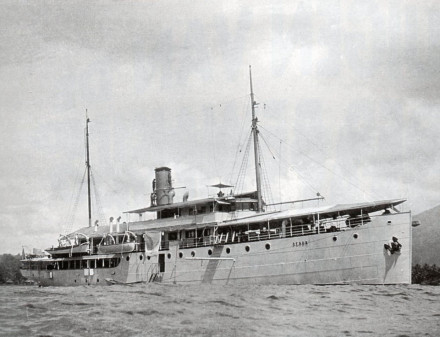History
Goevernementsmarine
The Hr. Ms. Deneb was a Dutch ship of the Goevernementsmarine ('Governor's Navy, the navy of the former Dutch East Indies) of the Aldebaran class. These ships often served as research or service vessels and had no military function. The ship was commissioned in 1916 and worked as a stationed vessel in Menado on North Celebes at the end of the twenties.
On September 1st, 1939, the whole navy of the Goevernementsmarine was militarised because of the threat of war, causing all ships to become part of the Dutch Royal Navy. The ships got different jobs: a part was used in guard and research services or worked on buoys and coastal lighting, others were part of escort or supply services and again others were at the disposal of local navy commanders. In general, these were stationed at remote posts and had the job of transporting government officials, police or troops, as well as supplies, ammunition, gasoline.

When it was militarised, the Deneb operated as a stationed vessel in the Riau Archipellago with Tanjung Pinang as its base. Not much changed for the Deneb at first. It's commander, J.J. Neesen, wrote in his diary: "Asides from a few already instated research trips, our peace time services were maintained for the time being. To accommodate the limitations of the peacetime research services, the station Riau and underlying area was appointed the police cruiser Hr. Ms. Ceram (1938). Regular practice with guns, rifles and handguns was conducted however. Sailing without lights was implemented."
Demise
On February 4th, 1942, the Deneb was attacked by seven Japanese bombers when she was approaching the island of Pulau Rukan Selatan (called Zuid-Broeder by the Dutch), on the southern entrance of the Durian Strait. The ship had no fighting chance since it did not have anti aircraft guns. Ten hits and near misses sank the ship. During the attack, two or three people were killed and over 20 people were badly injured.
In 1950, an eye witness account was published in Alle Hens, the journal for the personnel of the Dutch Royal Navy (translation by MaSS):
"Around the tiny ship, water started spouting up; these were the near misses, which made the Deneb, that weighed less then 800 tons, shake and squeak. Three bombs hit the ship and caused terrible destruction. In spite of the almost hopeless position that the ship was in, the small, old guns on board of the Deneb fired lustily. Yet the Japs [this old-fashioned slur is in the article from 1950] were not content with this first attack. The ship was still afloat and with a graceful turn, the planes returned, again aiming their bombs on the motionless Deneb, that was dying in the Durian Strait.
A number of the crewmen, following their first instinct to save themselves, had jumped over board to escape this hell and tried to reach the shore swimming for better or for worse. The second attack was more successful - for the Japanese, that is: no less then 10 bombs hit the Deneb with a lot of noise, amongst which was a burner, that immediately set the whole aft part of the ship ablaze. Yet the crew kept on firing with the remaining gun: even though it was hard to hit the planes with these small guns, they wanted to force the enemy to fly higher with this defence, thus making the chance of being hit smaller. Yet this was to no avail: the countless hits had killed two crewmen and around twenty were lying on deck, badly wounded. And those who tried to reach the shore swimming, had not counted on the heavy currents of the Durian Strait."
A small government vessel called the Martha was lying near and from this ship, heroic rescue attempts were undertaken. The crew had gone ashore with their two dinghies when the attack started. But two sailors, T.J. Zitter and W.C.C. van Cadsand, got into the motorised sloop belonging to the Martha and went to the Deneb. They first aided the injured men on deck. They managed to survive the second Japanese attack when they made their way to shore.
The two sailors immediately went back to the Deneb with the sloop. Then, however, they saw the crew members that were trying to swim ashore being swept off by the current. They reached them just in time to prevent them from drowning. While they were returning, they were attacked with machine guns by the Japanese. When they had put the swimmers ashore, they returned to the Deneb. The remaining crew had succeeded in lowering one of the not so damaged sloops and they tried to save themselves with this. When they saw the motorised sloop coming, the returned to the ship to get in to this vessel. The two heroic rescuers managed to take one more wounded man from the ship and they went back to shore.
Later, most of the crew were taken as prisoners of war. Van Cadsand died in Thailand in 1943.
Description
Yard: Rijkswerf (Royal Navy shipyard), Amsterdam
Class: Aldebaran class
Armament:
2x 3,7 cm guns
| People on board | 45 |
|---|---|
| Power | 820 hp |
| Speed | 12 knots ~ 14 mph (22 km/h) |
| Length | 156 ¾ feet (47.8 m) |
| Width | 27 ½ feet (8.4 m) |
| Draft | 8 ¾ feet (2.7 m) |
| Displacement | 623 ton |
References
- tracesofwar.nl.
Gemilitariseerde schepen van de Gouvernements Marine. - Mark, C. (1950).
Vastwerken.
Alle Hens. - Mark, C. (1997).
Schepen van de Koninklijke Marine in WOII.